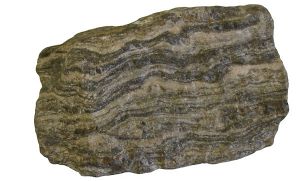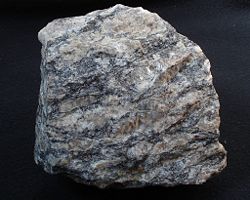Difference between revisions of "Gneiss" - New World Encyclopedia
({{Paid}}) |
|||
| Line 2: | Line 2: | ||
[[Image:Gneiss.jpg|thumb|Gneiss]] | [[Image:Gneiss.jpg|thumb|Gneiss]] | ||
| − | '''Gneiss''' is a | + | '''Gneiss''' is a widely distributed type of [[metamorphic rock]]. It is formed by high-grade regional [[metamorphic rock|metamorphic]] processes from preexisting formations that were originally either [[igneous rock|igneous]] or [[Sedimentary rock|sedimentary]] rocks. Gneissic rocks usually have medium to coarse [[Foliation (geology)|foliation]] (aligned by directed pressure) and are largely [[Recrystallization|recrystallized]]. They do not, however, carry large quantities of platy [[mineral]]s such as [[mica]]s or [[Chlorite group|chlorites]]. The term '''gneissose''' is used to describe rocks with properties similar to gneiss. |
| − | + | The study of gneiss has helped scientists understand the geological processes by which this metamorphic rock can be formed. Also, using a [[radiometric dating]] technique, researchers have identified the '''Acasta Gneiss''' (in [[Northwest Territories]], [[Canada]]) as the oldest known crustal [[Rock (geology)|rock]] [[outcrop]] in the world. | |
| − | + | == Etymology == | |
The word "gneiss" is from an old [[Saxony|Saxon]] mining term that seems to have meant decayed, rotten, or possibly worthless material. | The word "gneiss" is from an old [[Saxony|Saxon]] mining term that seems to have meant decayed, rotten, or possibly worthless material. | ||
| + | |||
| + | == Composition and classification == | ||
| + | |||
| + | Gneisses that are metamorphosed igneous rocks or their equivalent are termed [[granite]] gneisses, [[diorite]] gneisses, and so forth. Depending on their [[composition]], they may also be called [[garnet]] gneiss, [[biotite]] gneiss, [[albite]] gneiss, and so forth. ''Orthogneiss'' designates a gneiss derived from an igneous rock, and ''paragneiss'' is one from a sedimentary rock. | ||
| + | |||
| + | Gneiss resembles granite, except that the minerals are arranged into bands. Sometimes it is difficult to tell the difference between gneiss and a schist because some gneiss appears to have more mica than it really does. This is especially true with mica-rich parting planes. If a rock shows minerals occurring in distinct bands, it is probably gneiss. | ||
===Augen gneiss=== | ===Augen gneiss=== | ||
[[Image:Augen-gneiss-2.jpg|right|thumb|250px| Augen gneiss from Rio de Janeiro, Brazil.]] | [[Image:Augen-gneiss-2.jpg|right|thumb|250px| Augen gneiss from Rio de Janeiro, Brazil.]] | ||
| − | Augen gneiss is a coarse-grained gneiss, interpreted as resulting from metamorphism of granite | + | Augen gneiss (from the German ''augen'', meaning "eyes") is a coarse-grained gneiss, interpreted as resulting from metamorphism of granite. It contains characteristic elliptic or lenticular shear-bound feldspar [[porphyroclast]]s within the layering of bands of quartz, biotite, and magnetite. |
| − | |||
| − | |||
== Acasta Gneiss == | == Acasta Gneiss == | ||
| Line 21: | Line 25: | ||
The '''Acasta Gneiss''' is the oldest known crustal [[Rock (geology)|rock]] [[outcrop]] in the world. It is an [[Archaean]] [[tonalite]] gneiss in the [[Slave craton]] in [[Northwest Territories]], [[Canada]]. | The '''Acasta Gneiss''' is the oldest known crustal [[Rock (geology)|rock]] [[outcrop]] in the world. It is an [[Archaean]] [[tonalite]] gneiss in the [[Slave craton]] in [[Northwest Territories]], [[Canada]]. | ||
| − | The Acasta Gneiss is named for the nearby [[Acasta River]] east of [[Great Slave Lake]] some 350 km north of [[Yellowknife, Northwest Territories|Yellowknife]]. The rock exposed in the outcrop formed just over four billion (4 x 10<sup>9</sup>) years ago; an age based on [[radiometric dating]] of [[zircon]] crystals | + | The Acasta Gneiss is named for the nearby [[Acasta River]] east of [[Great Slave Lake]] some 350 kilometers (km) north of [[Yellowknife, Northwest Territories|Yellowknife]]. It is found in a remote area of the [[Tlicho]] land settlement. The rock exposed in the outcrop formed just over four billion (4 x 10<sup>9</sup>) years ago; an age based on [[radiometric dating]] of [[zircon]] crystals (Bowring and Williams, 1999). Based on this estimate, it is the oldest known rock in the world. |
| − | |||
| − | |||
| − | |||
| − | |||
| − | + | In 2003, a team from the [[Smithsonian Institute]] collected a four-tonne boulder of Acasta Gneiss for display outside the [[National Museum of the American Indian]] in [[Washington, DC]]. | |
== See also == | == See also == | ||
| Line 35: | Line 35: | ||
* [[Schist]] | * [[Schist]] | ||
* [[Zircon]] | * [[Zircon]] | ||
| − | |||
==References== | ==References== | ||
| Line 47: | Line 46: | ||
* Shaffer, Paul R., Herbert S. Zim, and Raymond Perlman. 2001. ''Rocks, Gems and Minerals''. Rev. ed. New York: St. Martin's Press. ISBN 1582381321. | * Shaffer, Paul R., Herbert S. Zim, and Raymond Perlman. 2001. ''Rocks, Gems and Minerals''. Rev. ed. New York: St. Martin's Press. ISBN 1582381321. | ||
| − | *Bowring, S.A., and | + | * Bowring, S.A., and I.S. Williams. 1999. Priscoan (4.00-4.03 Ga) orthogneisses from northwestern Canada. ''Contributions to Mineralogy and Petrology'' 134:3-16. |
| − | *Stern, R.A., Bleeker | + | * Stern, R.A., and W. Bleeker. 1998. Age of the world's oldest rocks refined using Canada's SHRIMP. The Acasta gneiss complex, Northwest Territories, Canada. ''Geoscience Canada'' 25:27-31. |
== External links == | == External links == | ||
Revision as of 22:47, 18 May 2007
Gneiss is a widely distributed type of metamorphic rock. It is formed by high-grade regional metamorphic processes from preexisting formations that were originally either igneous or sedimentary rocks. Gneissic rocks usually have medium to coarse foliation (aligned by directed pressure) and are largely recrystallized. They do not, however, carry large quantities of platy minerals such as micas or chlorites. The term gneissose is used to describe rocks with properties similar to gneiss.
The study of gneiss has helped scientists understand the geological processes by which this metamorphic rock can be formed. Also, using a radiometric dating technique, researchers have identified the Acasta Gneiss (in Northwest Territories, Canada) as the oldest known crustal rock outcrop in the world.
Etymology
The word "gneiss" is from an old Saxon mining term that seems to have meant decayed, rotten, or possibly worthless material.
Composition and classification
Gneisses that are metamorphosed igneous rocks or their equivalent are termed granite gneisses, diorite gneisses, and so forth. Depending on their composition, they may also be called garnet gneiss, biotite gneiss, albite gneiss, and so forth. Orthogneiss designates a gneiss derived from an igneous rock, and paragneiss is one from a sedimentary rock.
Gneiss resembles granite, except that the minerals are arranged into bands. Sometimes it is difficult to tell the difference between gneiss and a schist because some gneiss appears to have more mica than it really does. This is especially true with mica-rich parting planes. If a rock shows minerals occurring in distinct bands, it is probably gneiss.
Augen gneiss
Augen gneiss (from the German augen, meaning "eyes") is a coarse-grained gneiss, interpreted as resulting from metamorphism of granite. It contains characteristic elliptic or lenticular shear-bound feldspar porphyroclasts within the layering of bands of quartz, biotite, and magnetite.
Acasta Gneiss
The Acasta Gneiss is the oldest known crustal rock outcrop in the world. It is an Archaean tonalite gneiss in the Slave craton in Northwest Territories, Canada.
The Acasta Gneiss is named for the nearby Acasta River east of Great Slave Lake some 350 kilometers (km) north of Yellowknife. It is found in a remote area of the Tlicho land settlement. The rock exposed in the outcrop formed just over four billion (4 x 109) years ago; an age based on radiometric dating of zircon crystals (Bowring and Williams, 1999). Based on this estimate, it is the oldest known rock in the world.
In 2003, a team from the Smithsonian Institute collected a four-tonne boulder of Acasta Gneiss for display outside the National Museum of the American Indian in Washington, DC.
See also
ReferencesISBN links support NWE through referral fees
- Blatt, Harvey, and Robert J. Tracy. 1995. Petrology: Igneous, Sedimentary, and Metamorphic, 2nd ed. New York: W.H. Freeman. ISBN 0716724383.
- Farndon, John. 2006. The Practical Encyclopedia of Rocks & Minerals: How to Find, Identify, Collect and Maintain the World's best Specimens, with over 1000 Photographs and Artworks. London: Lorenz Books. ISBN 0754815412.
- Pellant, Chris. 2002. Rocks and Minerals. Smithsonian Handbooks. New York: Dorling Kindersley. ISBN 0789491060.
- Shaffer, Paul R., Herbert S. Zim, and Raymond Perlman. 2001. Rocks, Gems and Minerals. Rev. ed. New York: St. Martin's Press. ISBN 1582381321.
- Bowring, S.A., and I.S. Williams. 1999. Priscoan (4.00-4.03 Ga) orthogneisses from northwestern Canada. Contributions to Mineralogy and Petrology 134:3-16.
- Stern, R.A., and W. Bleeker. 1998. Age of the world's oldest rocks refined using Canada's SHRIMP. The Acasta gneiss complex, Northwest Territories, Canada. Geoscience Canada 25:27-31.
External links
- Ancient rock begins pilgrimage to museum
- ANCIENT CONTINENT OPENS WINDOW ON THE EARLY EARTH Science, December 17,1999
- Yuichiro Ueno research homepage
Credits
New World Encyclopedia writers and editors rewrote and completed the Wikipedia article in accordance with New World Encyclopedia standards. This article abides by terms of the Creative Commons CC-by-sa 3.0 License (CC-by-sa), which may be used and disseminated with proper attribution. Credit is due under the terms of this license that can reference both the New World Encyclopedia contributors and the selfless volunteer contributors of the Wikimedia Foundation. To cite this article click here for a list of acceptable citing formats.The history of earlier contributions by wikipedians is accessible to researchers here:
The history of this article since it was imported to New World Encyclopedia:
Note: Some restrictions may apply to use of individual images which are separately licensed.

